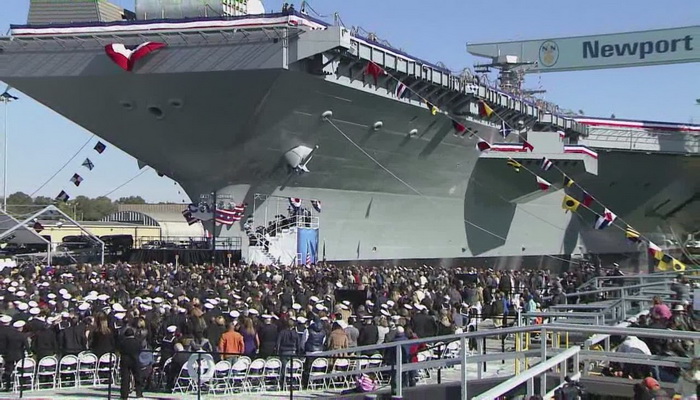The U.S. Navy has christened its newest Gerald R. Ford-class aircraft carrier, USS John F. Kennedy (CVN 79), during a ceremony on Saturday, December. 6, at the Newport News Shipbuilding. John F. Kennedy is the second aircraft
carrier of the Gerald R. Ford class, slated to replace USS Nimitz (CVN 68), when that ship is decommissioned.
CVN 79 is the second aircraft carrier to honor President John F. Kennedy for a lifetime of service to the nation. The president wore the uniform of our nation as a Navy lieutenant during World War II and served as the 35th President of the United States, from January 1961 to November 1963.
John F. Kennedy, along with its embarked air wing and other strike group assets, will provide the core capabilities of forward presence, deterrence, sea control, power projection, maritime security and humanitarian assistance.
Built by Huntington Ingalls Industries’ Newport News Shipbuilding division, the Gerald R. Ford class incorporates advances in technology, such as a new propulsion system, electric plant, Electromagnetic Aircraft Launch System (EMALS), Advanced Arresting Gear (AAG), machinery control, radars and integrated warfare systems.
At 1,092 feet in length and 100,000 tons, CVN 79 incorporates more than 23 new technologies, comprising dramatic advances in propulsion, power generation, ordnance handling and aircraft launch systems. These innovations will support a 33% higher sortie generation rate at a significant cost savings, when compared to Nimitz-class carriers. The Gerald R. Ford class also offers a significant reduction—approximately $4 billion per ship—in life cycle operations and support costs compared to the earlier Nimitz class.
The new technology and warfighting capabilities that the John F. Kennedy brings to the fleet will transform naval warfare, supporting a more capable and lethal forward-deployed U.S. naval presence. In an emerging era of great power competition, CVN 79 will serve as the most agile and lethal combat platform in the world, with improved systems that enhance interoperability among other platforms in the carrier strike group, as well as with the naval forces of regional allies and partners.

